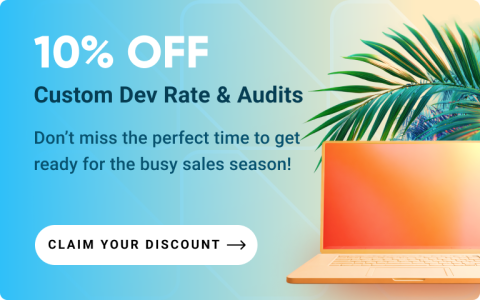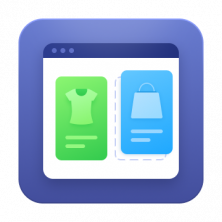Think about the last time you wandered into a brick-and-mortar store. Have you ever noticed that complementary and similar things are listed right next to each other? The ketchup being next to the mustard is on purpose, and so are the little candy and trinkets placed at eye level right before you check out.
In e-commerce stores, this could also manifest in the form of a coupon, deal, or last-minute saving right before your customers purchase. While figuring this out does take some data research on your end, the best way to achieve this level of accuracy is through a planogram. Join us as we explore the planogram definition, layout, and how planograms can affect your store.
What is a Planogram?
A retail planogram is a blueprint for your store's shelves, visually representing how products should be arranged to optimize sales, customer flow, and overall store experience. It's a strategic map, guiding you on where to place each item for maximum impact when arranging products on retail store shelves.
To create a planogram, you need to consider various factors like product category, sales data, traffic flow and what customers frequent which area of the store to maximize the impact.
While planograms are traditionally a brick-and-mortar retail phenomenon, they can be used in e-commerce and physical/digital catalogs as well.
What is an E-commerce Planogram?
An e-commerce planogram, also known as a visual merchandiser, dictates how products are displayed on a website or digital platform to boost user experience and sales. Similar to its brick-and-mortar counterpart, a digital planogram optimizes the presentation of products in virtual "shelves" or listings, ensuring an appealing and intuitive layout for online shoppers.
There's a difference, though. Unlike traditional planograms used in physical retail settings, e-commerce planograms leverage technology and algorithms to dynamically adjust product displays based on real-time data, user preferences, and marketing objectives.
Types of Planograms
There are various types of e-commerce planograms, each designed for specific purposes to optimize digital merchandising:
- Category Planogram – This blueprint focuses on grouping similar products together, such as organizing electronics or beauty products into distinct categories within the online store.
- Featured Product Planogram – Featured Products highlight specific products or promotions prominently on the website or app homepage, maximizing visibility and driving immediate customer engagement.
- Recommendation Planogram – This e-commerce planogram uses data analytics and customer behavior insights to suggest complementary or related products based on browsing or purchase history, raising cross-selling opportunities.
- Coupon and Deal Planogram – This planogram highlights products that are eligible for discounts, deals, or special offers, attracting price-sensitive customers and encouraging immediate purchases.
- Last-Minute Savings Planogram – This type focuses on showcasing products or services that are available at a discounted rate for a limited time, leveraging urgency to drive quick purchasing decisions.
Combining all these e-commerce planogram methods can bring a lot of business into your online store and maximize the share of wallet for your customers. For example, high-ticket items can be strategically placed in bundles with other products or listed in the 'featured' category to optimize sales potential.
Best part? Since all these planograms are digital, you don't need to continuously collect fresh data to adjust the layouts. Instead, you can leverage personalization algorithms that automatically group, promote, and suggest various items on your behalf.
Why Planograms Matter More Than You Think
While it may seem that planograms are all about aesthetics, they're a strategic tool in your digital retail belt. Smart product placement can influence customer behavior, encouraging them to pick up high-margin items or explore new products. A well-organized online store is easier to navigate, leading to happier and more likely return customers.
Above all else, customers want personalization. According to a study by Deloitte, 78% of customers seek personalization that helps them save money. 84% said special discount offers or bundles had a medium or high influence on their purchase decisions. E-commerce planograms are what drive personalized offers in your store, so don't underestimate their influence on the LTV and an average check.
How Do I Craft a Winning E-commerce Planogram?
Building an e-commerce planogram involves analyzing your website layout, customer browsing patterns, and sales data. Here's a simplified roadmap:
Gather Your Intel
Analyze sales trends, identify popular and slow-moving items, and consider navigation paths within your online store. Consider external factors such as seasonal trends or market influences to refine your planogram strategy.
If you notice trends happening around your vicinity, you can brainstorm ways to add to your planogram. Don't get stuck with analysis paralysis, however, as making a choice and observing the outcome can give you more benefits.
Map it Out
Outline a digital layout that organizes products by categories and highlights best-selling items or promotions prominently. Before doing this, take a look at your low-ticket items and purchase inventories.
This helps you not assume anything. For example, you might assume that displaying the best-selling category in the checkout product feed is efficient based on the general popularity of those items. However, by analyzing your sales data, you may discover that it's the personalized "Often bought with this item..." feed that actually performs best in the checkout flow of your e-commerce site.
Being More Software Savvy
Although it isn't necessary at all, consider using planogram software for a more sophisticated approach. These tools allow you to create digital layouts, experiment with different configurations, and even factor in product dimensions.
Using tech can quickly pay for itself as it saves you the time and effort of creating one from scratch, and data may be much easier to analyze. If you are already using Magento 2, the planogram merchandiser is an extremely useful tool.
Thought that was all? Here are some pro tips to turn you into a planogram powerhouse:
- Don't Be Static – Regularly review and update your planograms to reflect changing sales trends and customer browsing behavior.
- Embrace Experimentation – Test different product placements to see what resonates best with your customers.
- Think Outside the Shelf Edge – Consider using promotional banners, product labels, and interactive elements (e.g. quizzes) to enhance your product presentation further.
Looking for a Helping Hand in Visual Merchandising?
If you are an e-commerce store owner and don't already have a planogram, you need one ASAP. Creating a planogram can give you an unfair advantage over your competitors and can organize your thoughts and layout into a visual blueprint that is super easy to communicate and improve upon.
For those on the Magento 2 platform, Amasty's Visual Merchandiser extension is a great start. It allows you to create drag-and-drop planograms, manage product placement rules, and even generate visual reports within your Magento 2 store.
Start unleashing the power of planograms. By strategically organizing your shelves, you can create a compelling shopping experience, boost sales, and keep your customers coming back for more.
Frequently asked questions
- Not necessarily! You can start with a simple pen-and-paper sketch. However, certain software can offer valuable features for larger stores or complex layouts.
- Ideally, review and update your planograms quarterly or whenever you experience significant changes in sales or product offerings.
Planograms can improve inventory management by helping you allocate shelf space efficiently, minimizing wasted space and reduce stockouts. They can also improve the customer experience by creating a well-organized and easy-to-navigate store layout, leading to happier customers and referrals.
- The time commitment varies depending on the complexity of your store and the level of detail you want in your planogram. You can create a basic one with pen and paper quickly while using software and incorporating intricate details might take longer. Don't be afraid to experiment and see what works well for you and your time.





























